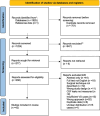Skull Base Repair following Resection of Vestibular Schwannoma: A Systematic Review (Part 1: The Retrosigmoid Approach)
- PMID: 39444767
- PMCID: PMC11495915
- DOI: 10.1055/a-2222-0184
Skull Base Repair following Resection of Vestibular Schwannoma: A Systematic Review (Part 1: The Retrosigmoid Approach)
Abstract
Objective Despite advances in skull-base reconstruction techniques, cerebrospinal fluid (CSF) leaks remain a common complication following retrosigmoid (RS) vestibular schwannoma (VS) surgery. We aimed to review and classify the available strategies used to prevent CSF leaks following RS VS surgery. Methods A systematic review, including studies of adults undergoing RS VS surgery since 2000, was conducted. Repair protocols were synthesized into a narrative summary, and a taxonomic classification of techniques and materials was produced. Additionally, the advantages, disadvantages, and associated CSF leak rates of different repair protocols were described. Results All 42 studies were case series, of which 34 were retrospective, and eight were prospective. Repair strategies included heterogeneous combinations of autografts, xenografts, and synthetic materials. A repair taxonomy was produced considering seven distinct stages to CSF leak prevention, including intraoperative approaches to the dura, internal auditory canal (IAC), air cells, RS bony defect, extracranial soft tissue, postoperative dressings, and CSF diversion. Notably, there was significant heterogeneity among institutions, particularly in the dural and IAC stages. The median postoperative incidence of CSF leaks was 6.3% (IQR: 1.3-8.44%). Conclusions The intraoperative strategies used to prevent CSF leaks during RS VS surgery vary between and within institutions. As a result of this heterogeneity and inconsistent reporting of CSF leak predictive factors, a meaningful comparative analysis of repair protocols was not feasible. Instead, we propose the development of a prospective multicenter observational evaluation designed to accurately capture a comprehensive dataset of potential CSF risk factors, including all stages of the operative repair protocol.
Keywords: CSF leak; ear nose and throat; neurosurgery; retrosigmoid approach; skull base repair; vestibular schwannoma.
The Author(s). This is an open access article published by Thieme under the terms of the Creative Commons Attribution License, permitting unrestricted use, distribution, and reproduction so long as the original work is properly cited. ( https://creativecommons.org/licenses/by/4.0/ ).
Conflict of interest statement
Conflict of Interest None declared.
Figures


Similar articles
-
Skull Base Repair following Resection of Vestibular Schwannoma: A Systematic Review (Part 2: The Translabyrinthine Approach).J Neurol Surg B Skull Base. 2024 Jan 22;85(Suppl 2):e131-e144. doi: 10.1055/a-2222-0016. eCollection 2024 Oct. J Neurol Surg B Skull Base. 2024. PMID: 39444760 Free PMC article.
-
Cerebrospinal Fluid Leak Rate after Vestibular Schwannoma Surgery via Middle Cranial Fossa Approach.J Neurol Surg B Skull Base. 2019 Aug;80(4):437-440. doi: 10.1055/s-0038-1675752. Epub 2018 Nov 26. J Neurol Surg B Skull Base. 2019. PMID: 31316890 Free PMC article.
-
Prevention and management of cerebrospinal fluid leak following vestibular schwannoma surgery.Laryngoscope. 2004 Mar;114(3):501-5. doi: 10.1097/00005537-200403000-00022. Laryngoscope. 2004. PMID: 15091225
-
Impact of Reconstruction With Hydroxyapatite Bone Cement on CSF Leak Rate in Retrosigmoid Approach to Vestibular Schwannoma Resection: A Review of 196 Cases.Otol Neurotol. 2021 Jul 1;42(6):918-922. doi: 10.1097/MAO.0000000000003072. Otol Neurotol. 2021. PMID: 33481543 Review.
-
Minimally invasive endoscopic repair of refractory lateral skull base cerebrospinal fluid rhinorrhea: case report and review of the literature.Neurosurg Focus. 2018 Mar;44(3):E8. doi: 10.3171/2017.12.FOCUS17664. Neurosurg Focus. 2018. PMID: 29490552 Review.
References
-
- Sughrue M E, Yang I, Aranda D et al.Beyond audiofacial morbidity after vestibular schwannoma surgery. J Neurosurg. 2011;114(02):367–374. - PubMed
-
- McRackan T R, Brackmann D E. Historical perspective on evolution in management of lateral skull base tumors. Otolaryngol Clin North Am. 2015;48(03):397–405. - PubMed
-
- Ansari S F, Terry C, Cohen-Gadol A A. Surgery for vestibular schwannomas: a systematic review of complications by approach. Neurosurg Focus. 2012;33(03):E14. - PubMed
-
- Fang C, Zhu T, Zhang P, Xia L, Sun C. Risk factors of neurosurgical site infection after craniotomy: a systematic review and meta-analysis. Am J Infect Control. 2017;45(11):e123–e134. - PubMed
-
- Sathaporntheera P, Saetia K. Risk factors associated with CSF leakage and complications after retrosigmoid surgery. Interdiscip Neurosurg. 2020;22:100865.
LinkOut - more resources
Full Text Sources
Research Materials

